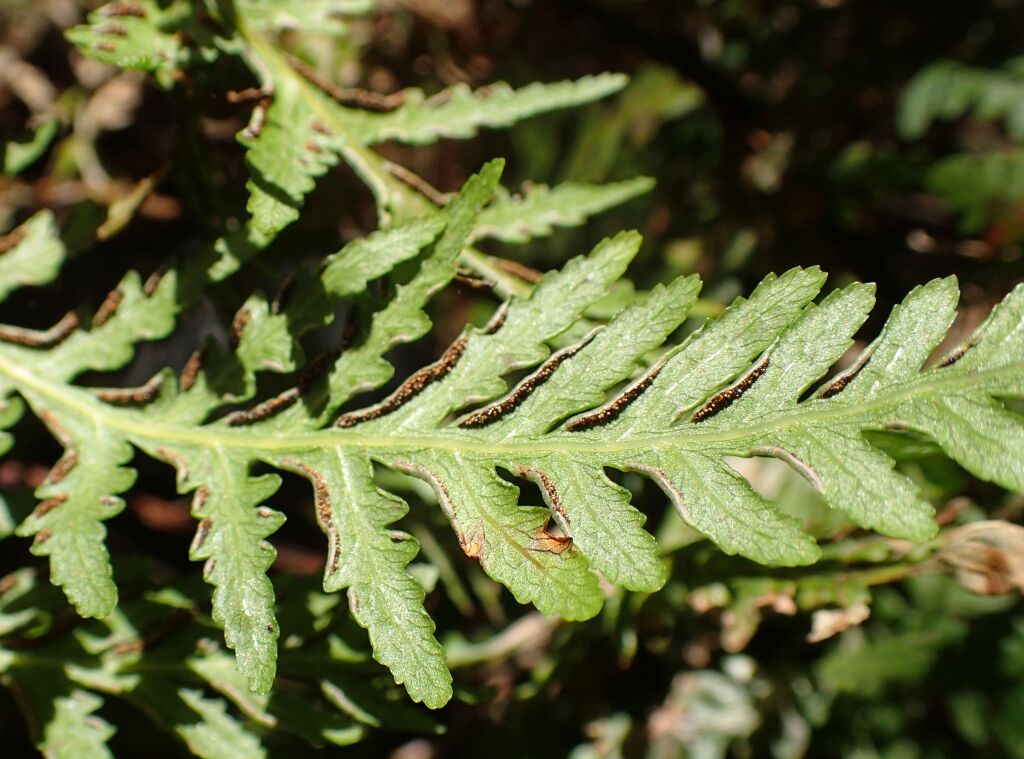Pteris epaleata
D.J.Ohlsen Netted BrakeRhizome erect, short and stout, covered with brown scales with slender tips. Fronds tufted, erect but arching at tips, 80–160 cm long, relatively soft-textured. Stipe long, stout, brown and purplish towards base, brown to olive-green above. Lamina 3–4-pinnate, broadly triangular, dark green, glabrous except for scattered, short hairs along lower surface of midveins and rachises; rachises often pale and yellowish. Pinnae narrower in fertile frond; primary pinnae distant, lower pinnae asymmetrically triangular to ovate; secondary pinnae triangular-ovate to ovate-oblong, bases decurrent, apices frequently tapering and serrate. Pinnules obliquely oblong, sessile, decurrent, margins broadly and deeply serrate or crenate; veins free towards margin but anastomosing to form series of areoles near midvein. Sori continuous along lateral margins, often extending down decurrent bases but never around tips.
GipP, OtP, WaP, WPro, HSF, OtR, Strz, VAlp. Also NSW, Qld, Tas. (including King Is.). New Zealand, South Pacific islands. Although restricted in distribution in Victoria, it is often locally abundant and conspicuous, favouring seepages, stream banks and damp flats in shady forests (e.g. Beech Forest in the Otway Range, Dandenong Ranges where rare, Wilsons Promontory, etc.).
Pteris epaleata is a segregate of Pteris comans G.Forst., the latter name misapplied to plants in Australia and New Zealand. P. comans has been broadly circumscribed to encompass a variable assemblage of ferns throughout the Pacific and eastern Australia with anastomosing veins and large, dissected fronds. Populations from the tropical Pacific differ from populations in Australia and New Zealand in frond dissection and indumentum. Australian and New Zealand populations were shown to be more closely related to other New Zealand species than to tropical Pacific P. comans and have recently been described as a new species, P. epaleata (Ohlsen et al. 2020).
The fronds of Pteris epaleata are very similar to Histiopteris incisa, but the latter has distinctive paired pinnules at the base of each pinna, and the margins are entire or only slightly crenate (never serrate). The lamina of P. epaleata is also darker in colour, and never has the blue-green to pale green coloration of H. incisa. See also notes under P. tremula.
Entwisle, T.J. (1994). Ferns and allied plants (Psilophyta, Lycopodiophyta, Polypodiophyta). In: Walsh, N.G.; Entwisle, T.J., Flora of Victoria Vol. 2, Ferns and Allied Plants, Conifers and Monocotyledons, pp. 13–111. Inkata Press, Melbourne.
 Spinning
SpinningMisapplications
Ohlsen, D.J.; Brownsey, P.J.; Shepherd, L.D.; Perrie, L.R.; May, E.L.; Chen, C-W.; Bayly, M.J. (2020). Pteris epaleata, a new fern species from Australia and New Zealand segregated from P. comans (Pteridaceae). Muelleria 39: 17–26.

